Eisriesenwelt
The World of the Ice Giants
Useful Information
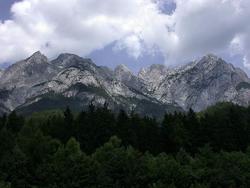
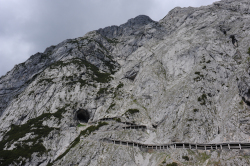
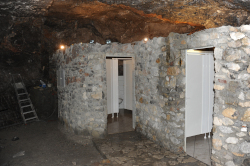
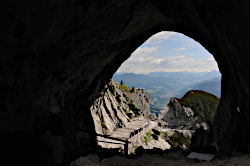
| Location: |
Near Werfen (Salzburg).
From Werfen use the Eisriesenwelt road (only cars, taxi from Werfen centre) to the parking lot. 10 minutes comfortable walk to the restaurant Wimmerhütte (1080 m) and the station of the Eisriesenwelt cableway. It takes 4 min to the Dr. Friedrich Oedl-Haus on top of the Achselkopf (1575 m asl), starting point of the guided tours. (47.5108640, 13.1932301) |
| Open: |
MAY to OCT daily 8:30-15. [2023] |
| Fee: |
Cable car plus cave:
Adults EUR 42, Children (15-18) EUR 29, Children (5-14) EUR 21. Groups (20+): Adults EUR 38, Children (15-18) EUR 27, Children (5-14) EUR 19. Online: Adults EUR 38, Children (15-18) EUR 27, Children (5-14) EUR 19. [2024] |
| Classification: |
 Karst Cave Karst Cave
 ice cave. ice cave.
 The Most Expensive Show Cave The Most Expensive Show Cave
|
| Light: |
 Carbide Lamps Carbide Lamps
 Magnesium Light Magnesium Light
|
| Dimension: |
L=42,000 m, VR=-407 m, A=1,641 m asl. Portal: H=18 m, W=20 m. |
| Guided tours: |
D=120 min, L=800 m. V=200,000/a [2010] |
| Photography: | not allowed |
| Accessibility: | no |
| Bibliography: |
Nikolaus Schaffer (1987): Alexander Von Mörk 1887-1914 - Der Entdecker der Eisriesenwelt als Maler, 27 pp 19 B&W 20 colour photos. HB. 
This is a luxurious book, printed on art paper, to commemorate the birth of Alexander von Mörk, the discoverer of the Eisriesenwelt Ice Cave, near Salzburg in Austria. Alexander von Mörk was a noted artist and many of his paintings illustrating local caves are reproduced herein. Complete with potted biography, this is an interesting account of a famous Austrian caver, tragically killed in the first months of the Great War. O. Lehmann (1922): Die große Eishöhle im Tennengebirge (Salzburg). (Eisriesenwelt) [The Great Ice Cave in Tennengebirge (Salzburg). (Eisriesenwelt)] in: Speläologisches Jahrbuch [Vol] III. Jahrgang, Heft [Part] 3/4 1922. [Speleological Year Book published in Vienna by the Speleological Institute.] 51-168 pp 27 plates 75 figs etc. 
R. Oedl (1922): Die Vermessung der grossen Eishöhle im Tennengebirge (Salzburg), in: Speläologisches Jahrbuch [Vol] III, S. 5-30, Salzburg. 
|
| Address: |
Eisriesenwelt GmbH, Getreidegasse 21, A-5020 Salzburg, Tel: +43-662-842690-14.
E-mail: Dr. Friedrich Oedl-Haus, Tel: +43-6468/248. |
| As far as we know this information was accurate when it was published (see years in brackets), but may have changed since then. Please check rates and details directly with the companies in question if you need more recent info. |
|
History
| 1849 | entrance discovered, but not entered. |
| 1879 | first explored by Salzburg naturalist Anton von Posselt-Czorich for 200 m. |
| 1912 | first expedition into the cave. |
| 1913 | exploration by Alexander von Mörk, Angermayer and Riehl. |
| 1920 | Forscherhütte (explorer’s hut) and the first primitive climbing facilities to and in the cave were built in order to make it easier for cavers to reach the cave. |
| 1924 | first wooden walkways on the ice built. |
| 1925 | Dr. Friedrich Oedl-Haus lodge built beneath the Forscherhütte. |
| 1953 | single lane gravel road to the foot of the mountain opened. |
| 1955 | cable car opened to the public. |
Description
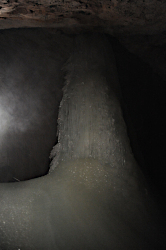
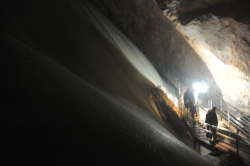
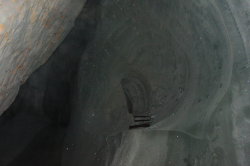
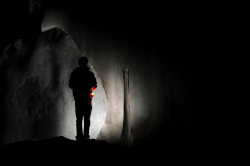
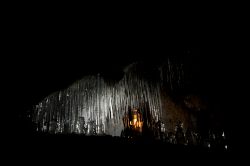
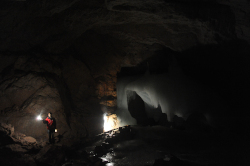
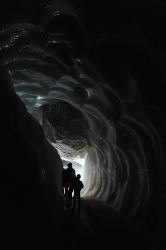
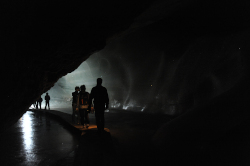
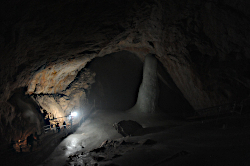
The Eisriesenwelt (lit: World of the Ice Giants, Werfen Ice Caves) is the largest ice cave of the world. The halls are decorated with all kinds of ice formations, gigantic columns and towers of ice, ice waterfalls and glaciers. Huge chambers totally bare of any speleothems with several meters of ice on the floor, passages almost completely filled with ice, and passages which are completely filled with ice. Sometimes it is necessary to cut a tunnel through the ice for the path. At certain locations the ice melts and refreezes and forms icicles.
This cave is a so-called dynamic ice cave, it is located in a height above sea level where the average temperature is below zero. Several entrances to the cave allow chilly air currents to flow in and out. So it is not a cold trap like most other ice caves, the climate here is actually so cold and the average temperature outside is slightly below 0 °C. So the ice formations change slightly every year, because warmer air during late summer causes them to melt and fresh water freezes on top in spring. The changing ice makes it impossible to build trails or electric light inside the cave. The paths move with the ice, and have to be replaced regularly. They are constructed of wooden planks, which can be disassembled and then reassembled for the new paths. The light system would be quite difficult because there is no electricity, some kind of generator would be needed. But the main problem is that the lamps and the wires would be destroyed after some time by the moving ice. Visitors are equipped with carbide lamps and the most spectacular sights are illuminated by the guide by burning magnesium ribbon.
The Eisriesenwelt is located in the west wall of the Hochkogel in the Tennengebirge. On days with good weather there is a spectacular view of the surrounding mountain ranges of the Hohe Tauern from the huge cave entrance. The trail to the cave goes up in serpentines through the steep limestone wall. The part of the trail at risk of rock fall is covered by a concrete roof. In front of the entrance there is a cave toilet in a small natural cave, use it, because there is no other possibility on the two-hour tour.
This site is a crowded tourist destination, often with long queues, people who are on holiday and careless, and have no idea what awaits them. On their website they state you will go up a total of 134 metres in altitude. This corresponds to climbing the stairs of a 40-storey high-rise building. It is the personal responsibility of each visitor to decide whether they are capable of doing this. We want to make sure you have a good impression of the tour, so we explain the trip in detail. This is a mountaineering trip on very well developed trail, but nevertheless an alpine experience. The tour time given with 2 hours is only the cave tour, but the cave is high up on a mountain and getting there requires some effort and time.
About 200,000 tourists come here every year, and be aware that the season here is mostly July and August, so most of them visit in this short period. A mountain road from Werfen leads up to the cable car station. But it is only allowed to drive up to the ticket office, and on well-attended days, on weekends and during summer holidays you have to park at Werfen. There is a shuttle bus from the parking lot to the ticket office. We strongly recommend to visit the cave in spring or autumn, or at least very early in the morning. You should be aware, that a visit to this Natural Monument takes about 4-6 hours, including:
- finding a parking lot
- the ride up to the ticket office from Werfen with a shuttle bus
- purchasing a ticket
- walking to the cable car
- waiting for the next cable car
- cable car ride
- the walk to the entrance of the cave
- a guided tour of two hours
- and of course the same for the way back in opposite order.
Also the temperature is quite low, below 0 °C, and there might be a strong wind at some points. So we strongly recommend to take this trip serious. Pack a backpack with a warm fleece jacket and a wind resistant jacket, a warm cap and probably gloves. Take some food and something to drink with you. You can skip this if you intend a visit to the Dr. Oedl Haus, which we can recommend. Nevertheless, functional clothes and mountain approved walking shoes are absolutely necessary. If you want to avoid wearing a carbide lamp, for example if you plan to take pictures, we recommend to bring a headlamp. If you have a lamp the guides do not insist you take a carbide lamp.
The cave was formed during the late Tertiary, before the Alps were formed and then lifted with the surrounding limestone rocks. Obviously some parts of the cave, especially the area around the entrance were massively modified by the climate. But the main processes are mechanical, primarily caused by the freezing and melting of water.
This cave is in a very remote location, and the entrance to the caves is not visible from the valley. Since this steep, tricky rock was very hard to climb in former times, the cave was not discovered until 1849. Even though an enthusiastic report was published about the exploration, the world did not take notice of the caves for another 30 years. In 1879 the Salzburg naturalist Anton von Posselt-Czorich went about 200 m into the cave on his own, which makes him the official discoverer. He had to turn around after 200 m, as he reached a wall of ice, and his climbing gear was not sufficient for a steep wall of ice. At that time mountaineers used boots with leather soles and iron nails. He published a detailed report of his discovery in the Alpenverein magazine one year later. The Alpenverein was a club for mountaineers, and this was actually the heyday of the club, people starting to do all the first-time ascents in the Alps. But it seems they were not fond of cave exploration and the cave was forgotten about again. The cave became known as Posselthöhle (Posselt’s Cave).
The time of the first serious cave exploration was after World War I. Alexander von Mörk, founder of Salzburg cave exploration, realized the significance of Posselt’s report in 1913. A group of cavers including Angermayer and Riehl visited the cave. But this was immediately stopped by the outbreak of the war. Alexander von Mörk died in World War I at the age of 27 years. His last will was to be buried in Eisriesenwelt, his urn was later placed above one of the entrances into the cave. Explorers, such as Friedrich and Robert Oedl or Walter Czernig continued the exploration immediately after the war. In 1920, the Forscherhütte (explorer’s hut), in the local Austrian dialect Forscherhüttl, and the first primitive climbing facilities to and inside the cave were built in order to make it easier for cavers to reach the cave. The first guided tours took place in this year, so it is generally considered the opening of the show cave. Those tours required climbing and walking on ice, the skills and equipment of a mountaineer. They actually constructed the first wooden walkways on the ice in 1924 for the exploration. But it also allowed touristic visits and in 1925 a spacious lodge was built next to the explorer’s hut. It was named Dr. Friedrich Oedl-Haus in recognition of his hard work.
This was actually the beginning of the show cave, but at that time people had to walk to the cave all the way from Werfen. A cave tour was a full day mountaineering expedition. Nevertheless, there were so many visitors that they started the development. The mountain including the cave is public property managed by the Österreichische Bundesforste (Austrian Federal Forests). The Salzburger Verein für Höhlenkunde (Salzburg Association for Speleology) initially agreed a provisional lease with them. In 1928, a separate Eisriesenwelt company, the Eisriesenwelt-Gesellschaft mbH was established, the non-profit caving club was overwhelmed by the operation of the commercial cave. They made long-term contracts with the Bundesforste and in the 1950s built a single lane gravel road to the foot of the mountain. This road was not only for the visitors, it was necessary to build the cable car. This cable car ascends 500 m, from 1,084 m asl to 1,586 m asl, in a few minutes. The upper station was built beneath the existing lodge, as this was the closest suitable place. As the cave entrance is at 1,641 m asl, there is still some ascent to the cave entrance.
- See also
 Caves With a View
Caves With a View Member of the International Show Caves Association (ISCA)
Member of the International Show Caves Association (ISCA) Search DuckDuckGo for "Eisriesenwelt"
Search DuckDuckGo for "Eisriesenwelt" Google Earth Placemark
Google Earth Placemark Eisriesenwelt - Wikipedia (visited: 01-APR-2023)
Eisriesenwelt - Wikipedia (visited: 01-APR-2023) Eisriesenwelt Werfen, official website (visited: 01-APR-2023)
Eisriesenwelt Werfen, official website (visited: 01-APR-2023) Eisriesenwelt (The World of Ice Giants) - Atlas Obscura (visited: 06-NOV-2010)
Eisriesenwelt (The World of Ice Giants) - Atlas Obscura (visited: 06-NOV-2010) World’s Largest Ice Caves, Werfen (visited: 01-APR-2023)
World’s Largest Ice Caves, Werfen (visited: 01-APR-2023) Eisriesenwelt Werfen
Eisriesenwelt Werfen  (visited: 01-APR-2023)
(visited: 01-APR-2023) Victoria Brooks’ Greatest Escapes Travel Webzine (visited: 22-JAN-2012)
Victoria Brooks’ Greatest Escapes Travel Webzine (visited: 22-JAN-2012)
 Index
Index Hierarchical
Hierarchical Countries
Countries Maps
Maps